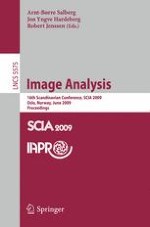This volume contains the papers presented at the Scandinavian Conference on Image Analysis, SCIA 2009, which was held at the Radisson SAS Scandinavian Hotel, Oslo, Norway, June 15–18. SCIA 2009 was the 16th in the biennial series of conferences, which has been organized in turn by the Scandinavian countries Sweden, Finland, D- mark and Norway since 1980. The event itself has always attracted participants and author contributions from outside the Scandinavian countries, making it an international conference. Theconferenceincludedafulldayoftutorialsand?vekeynotetalksprovided by world-renowned experts. The program covered high-quality scienti?c cont- butions within image analysis, human and action analysis, pattern and object recognition,colorimagingandquality,medicalandbiomedicalapplications,face andheadanalysis,computer vision,andmultispectralcoloranalysis. The papers werecarefully selected based on at least two reviews. Among 154 submissions 79 wereaccepted,leadingtoanacceptancerateof51%. SinceSCIAwasarrangedas a single-track event, 30 papers were presented in the oral sessions and 49 papers were presented in the poster sessions. A separate session on multispectral color science was organized in cooperation with the 11th Symposium of Multispectral Color Science (MCS 2009). Since 2009 was proclaimed the “International Year of Astronomy” by the United Nations General Assembly, the conference also contained a session on the topic “Imageand PatternAnalysis in Astronomyand Astrophysics. ” SCIA has a reputation of having a friendly environment, in addition to hi- quality scienti?c contributions. We focused on maintaining this reputation, by designing a technical and social program that we hope the participants found interesting and inspiring for new research ideas and network extensions. We thank the authors for submitting their valuable work to SCIA.
